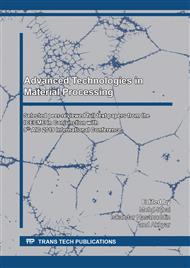[1]
T.B. Aulia, M. Afifuddin and L. Opirina, Bending Capacity Analysis of High-strength Reinforced Concrete Beams Using Geopolymer Fly Ash and Environmentally Friendly Slag as Fine Aggregate Substitution, Proceedings of the 7th Civil Engineering Conference in the Asian Region (CECAR7) (2016).
DOI: 10.1088/1757-899x/434/1/012199
Google Scholar
[2]
V. Sata, C. Jaturapitakkul and K. Kiattikomol, Utilization of palm oil fuel ash in high-strength concrete, J. Mater. Civ. Eng. 16 (2004) 623-628.
DOI: 10.1061/(asce)0899-1561(2004)16:6(623)
Google Scholar
[3]
P. Chindaprasirt, S. Homwuttiwong and C. Jaturapitakkul, Strength and water permeability of concrete containing palm oil fuel ash and rice husk-bark ash, Constr. Build. Mater. 21 (2007) 1492-1499.
DOI: 10.1016/j.conbuildmat.2006.06.015
Google Scholar
[4]
M.N. Haque and O. Kayali, Properties of high strength concrete using affine fly ash, Cem. Concr. Res. 28 (1998) 1445-1452.
DOI: 10.1016/s0008-8846(98)00125-2
Google Scholar
[5]
C.S. Poon, L. Lam and Y.L. Wong, A study on high strength concrete prepared with large volumes of low calcium fly ash, Cem. Concr. Res. 30 (2000) 447-455.
DOI: 10.1016/s0008-8846(99)00271-9
Google Scholar
[6]
M. Hasan, S. Husin and C. Nursaniah, Mechanical properties of concrete in compression exposed to sulfuric acid, Key Engineering Materials 711 (2016) 302-309.
DOI: 10.4028/www.scientific.net/kem.711.302
Google Scholar
[7]
Hamzani, Munirwansyah, M. Hasan, S. Sugiarto, The influence of the using waste tire rubber and natural zeolite as asphalt and cement replacement to compressive strength of semi-flexible pavement, IOP Conf. Series: Mater. Sci. and Eng. 523 (2019) 012034.
DOI: 10.1088/1757-899x/523/1/012037
Google Scholar
[8]
T.B. Aulia, Muttaqin, M. Afifuddin, M. Zaki and S. Merriza, Shear capacity analysis of high-strength reinforced concrete beams using geopolymer fly ash and palm oil blast furnace slag as additives and aggregate substitution, IOP Conf. Series: Mater. Sci. and Eng. 434 (2018) 012199.
DOI: 10.1088/1757-899x/434/1/012199
Google Scholar
[9]
T.B. Aulia, M. Afifuddin and M. Zaki, Studi Kapasitas Lentur Balok Beton Bertulang Mutu Tinggi Menggunakan Fly Ash Geopolimer dan Abu Cangkang Sawit sebagai Substitusi Semen, Prosiding Konferensi Nasional Teknik Sipil 12, (2018).
DOI: 10.24815/jarsp.v1i3.11782
Google Scholar
[10]
Laporan RTRW Kabupaten Aceh Besar, Banda Aceh, (2006).
Google Scholar
[11]
S. Handayani, Aplikasi Tanah Diatomae Sebagai Substitusi Semen dan Bahan Tambah Terhadap Sifat Mekanis Beton Normal, Tesis Magister Teknik Sipil, Universitas Syiah Kuala, (2018).
DOI: 10.54367/jrkms.v2i2.521
Google Scholar
[12]
M. Hasan, Husaini, N.M. Abdullah, Deformation and crack analysis of tunnel structure subjected to static distributed load using Pseudoshell model, IOP Conf. Series: Mater. Sci. and Eng. 523 (2019) 012037.
DOI: 10.1088/1757-899x/523/1/012034
Google Scholar
[13]
ACI 211.4R-93, Guide for selecting proportions for high-strength concrete with Portland cement and fly ash, ACI Committee 211, reapproved (1998).
DOI: 10.14359/9754
Google Scholar
[14]
ASTM C39/C39M, Standard test method for compressive strength of cylindrical concrete specimens, (2003).
Google Scholar
[15]
ASTM C469/469M, Standard test method for static modulus of elasticity and Poisson's ratio of concrete in compression, (2014).
Google Scholar


